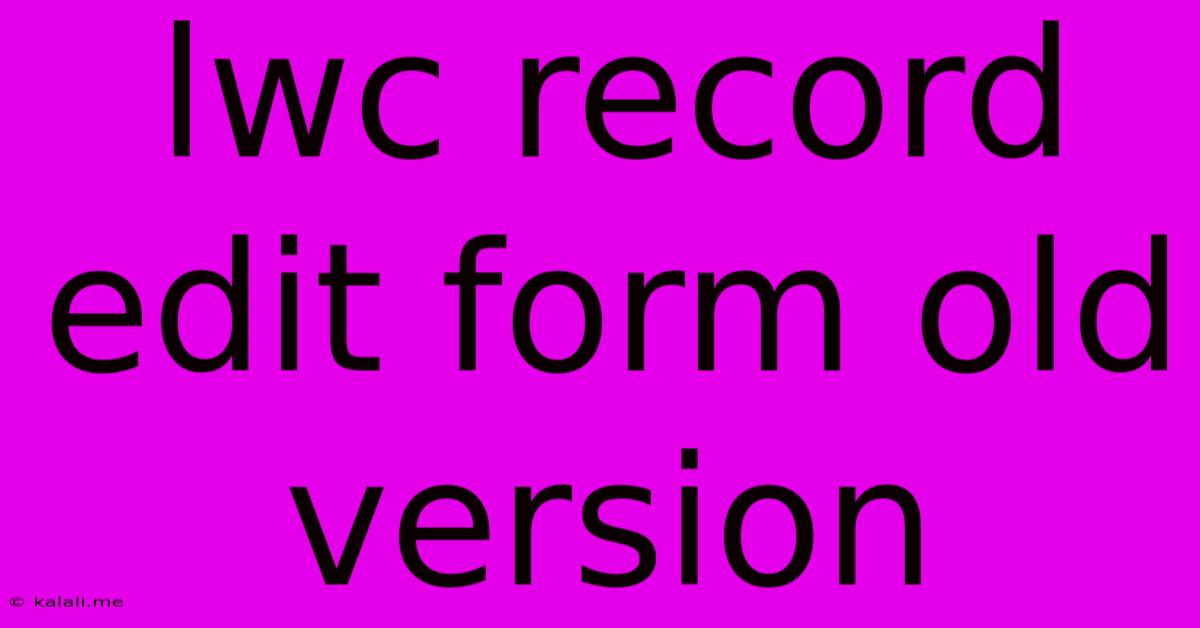Lwc Record Edit Form Old Version
Kalali
May 24, 2025 · 3 min read

Table of Contents
Navigating the Older LWC Record Edit Form: A Comprehensive Guide
This article dives deep into the intricacies of older versions of Lightning Web Components (LWC) record edit forms, providing a comprehensive guide for developers familiarizing themselves with this technology. While newer approaches exist, understanding the older methods remains crucial for maintaining legacy systems and appreciating the evolution of LWC development. We'll explore common challenges, best practices, and essential considerations for working with these forms.
The older LWC record edit form approach, often predating some of the more streamlined features available today, relied heavily on manipulating the DOM and leveraging the wire adapter for data fetching and updating. This method, while functional, required a deeper understanding of how to handle data changes and interact with the Salesforce platform's APIs.
Understanding the Core Components
The foundation of older LWC record edit forms typically involved:
@wireadapter: This crucial component was used to fetch record data using thegetRecordmethod. This allowed the component to access and display the fields of the record being edited. Proper handling of errors and loading states within thewirewas essential for a robust user experience.- Manual DOM Manipulation: Prior to more sophisticated methods for binding data to input fields, developers often relied on directly manipulating the Document Object Model (DOM). This involved using JavaScript to update the values of input elements based on the record data retrieved via the
@wireadapter. This approach could be more time-consuming and error-prone compared to newer declarative approaches. - Imperative Data Handling: Saving record changes often involved manually constructing an updated record object and using the
updateRecordmethod. This process required careful attention to detail to ensure accurate data representation and prevent data loss. - Event Handling: Custom events were frequently used for communication between the LWC component and other parts of the application, such as parent components or other LWCs.
Challenges and Best Practices
Working with older LWC record edit forms presented several challenges:
- Increased Complexity: The manual nature of DOM manipulation and imperative data handling led to more complex codebases, which could be harder to maintain and debug.
- Error Handling: Robust error handling was crucial, given the potential for network issues, API errors, and other problems that could disrupt the editing process.
- Testing: Thorough testing was essential to ensure that the component correctly handled various scenarios, including data validation, error conditions, and user interactions.
Best practices for working with these older forms included:
- Modular Design: Breaking down the component into smaller, more manageable modules could improve code organization and maintainability.
- Data Validation: Implementing comprehensive data validation to prevent invalid data from being submitted was essential.
- Clear Error Messages: Providing clear and informative error messages to users could enhance usability.
- Careful Event Handling: Using events effectively for communication within and outside the component could minimize complexity.
Migration Considerations
While these older methods remain functional, migrating to newer, declarative approaches offers significant advantages in terms of maintainability, scalability, and developer productivity. Newer LWC features simplify data binding and record manipulation, allowing for cleaner and more efficient code.
Consider these aspects when evaluating a migration:
- Complexity of existing code: A simple form might be quickly refactored, while a large and complex form might require a more phased approach.
- Impact on other parts of the application: The changes required might affect other components or integrations.
- Testing: Thorough regression testing is essential to ensure the migrated form functions correctly.
By understanding the core components, challenges, and best practices associated with older LWC record edit forms, developers can effectively work with legacy systems and plan successful migrations to newer, more efficient approaches. The lessons learned from these earlier methods provide valuable context for appreciating the advancements in modern LWC development.
Latest Posts
Latest Posts
-
Imagery Or Figurative Language From Romeo And Juliet
Jul 02, 2025
-
What Is A Quarter Of A Million
Jul 02, 2025
-
Which Of The Following Is True Concerning A Dao
Jul 02, 2025
-
How Long Can Catfish Live Out Of Water
Jul 02, 2025
-
Is Kanye West Related To Cornel West
Jul 02, 2025
Related Post
Thank you for visiting our website which covers about Lwc Record Edit Form Old Version . We hope the information provided has been useful to you. Feel free to contact us if you have any questions or need further assistance. See you next time and don't miss to bookmark.